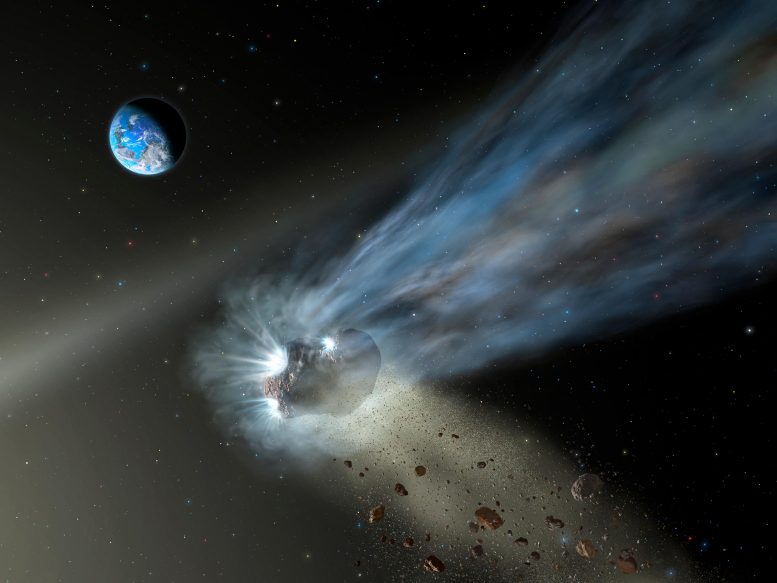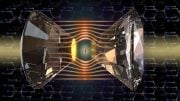
Illustration of a comet from the Oort Cloud as it passes through the inner solar system with dust and gas evaporating into its tail. SOFIA’s observations of Comet Catalina reveal that it’s carbon-rich, suggesting that comets delivered carbon to the terrestrial planets like Earth and Mars as they formed in the early solar system. Credit: NASA/SOFIA/Lynette Cook
In early 2016, an icy visitor from the edge of our solar system hurtled past Earth. It briefly became visible to stargazers as Comet Catalina before it slingshot past the Sun to disappear forevermore out of the solar system.
Among the many observatories that captured a view of this comet, which appeared near the Big Dipper, was the Stratospheric Observatory for Infrared Astronomy, NASA’s telescope on an airplane. Using one of its unique infrared instruments, SOFIA was able to pick out a familiar fingerprint within the dusty glow of the comet’s tail – carbon.
Now this one-time visitor to our inner solar system is helping explain more about our own origins as it becomes apparent that comets like Catalina could have been an essential source of carbon on planets like Earth and Mars during the early formation of the solar system. New results from SOFIA, a joint project of NASA and the German Aerospace Center, were published recently in the Planetary Science Journal.
“Carbon is key to learning about the origins of life,” said the paper’s lead author, Charles “Chick” Woodward, an astrophysicist and professor at the University of Minnesota’s Minnesota Institute of Astrophysics, in Minneapolis. “We’re still not sure if Earth could have trapped enough carbon on its own during its formation, so carbon-rich comets could have been an important source delivering this essential element that led to life as we know it.”
Frozen in Time
Originating from the Oort Cloud at the farthest reaches of our solar system, Comet Catalina and others of its type have such long orbits that they arrive on our celestial doorstep relatively unaltered. This makes them effectively frozen in time, offering researchers rare opportunities to learn about the early solar system from which they come.
SOFIA’s infrared observations were able to capture the composition of the dust and gas as it evaporated off the comet, forming its tail. The observations showed that Comet Catalina is carbon-rich, suggesting that it formed in the outer regions of the primordial solar system, which held a reservoir of carbon that could have been important for seeding life.
While carbon is a key ingredient of life, early Earth and other terrestrial planets of the inner solar system were so hot during their formation that elements like carbon were lost or depleted. While the cooler gas giants like Jupiter and Neptune could support carbon in the outer solar system, Jupiter’s jumbo size may have gravitationally blocked carbon from mixing back into the inner solar system. So how did the inner rocky planets evolve into the carbon-rich worlds that they are today?
Primordial Mixing
Researchers think that a slight change in Jupiter’s orbit allowed small, early precursors of comets to mix carbon from the outer regions into the inner regions, where it was incorporated into planets like Earth and Mars. Comet Catalina’s carbon-rich composition helps explain how planets that formed in the hot, carbon-poor regions of the early solar system evolved into planets with the life-supporting element.
“All terrestrial worlds are subject to impacts by comets and other small bodies, which carry carbon and other elements,” said Woodward. “We are getting closer to understanding exactly how these impacts on early planets may have catalyzed life.”
Observations of additional new comets are needed to learn if there are many other carbon-rich comets in the Oort Cloud, which would further support that comets delivered carbon and other life-supporting elements to the terrestrial planets.
Reference: “The Coma Dust of Comet C/2013 US10 (Catalina): A Window into Carbon in the Solar System” by Charles E. Woodward, Diane H. Wooden, David E. Harker, Michael S. P. Kelley, Ray W. Russell and Daryl L. Kim, 8 February 2021, Planetary Science Journal.
DOI: 10.3847/PSJ/abca3e
SOFIA is a joint project of NASA and the German Aerospace Center. NASA’s Ames Research Center in California’s Silicon Valley manages the SOFIA program, science, and mission operations in cooperation with the Universities Space Research Association, headquartered in Columbia, Maryland, and the German SOFIA Institute at the University of Stuttgart. The aircraft is maintained and operated by NASA’s Armstrong Flight Research Center Building 703, in Palmdale, California.









“… it becomes apparent that comets like Catalina could have been an essential source of carbon on planets like Earth and Mars during the early formation of the solar system”
Why do planets need comets to ‘deliver’ carbon (and other stuff)?
The planets (and everything else in the solar system) coalesced from the same primordial gas and dust as the comets; so why wouldn’t it just have carbon?
Good question!
In fact that is a competing hypothesis in this open field what I have read. The easiest way to try to track the origin of volatiles is to look at the D/H ratio of hydrogen isotopes, which is doable from samples but also spectroscopy of comet tails I think. The further away from the Sun, the relative more of the lighter isotopes that is easier to heat away. And when astrophysicists does that they find that a minor part of water could come from comets.
What the competing hypothesis center on is that different gases will have different “ice lines”, zones in the protoplanetary disk where the gas freeze out – first water, then carbon dioxide, last nitrogen for example of important gases. But that is not the entire story, as you imply, a lot of the elements participate in rock formation.
“Was Earth’s Water Always Here? Unexpected Meteorite Composition Provides Origin Evidence”
“In the journal Science, scientists from the Centre de Recherches Pétrographiques et Géochimiques in Nancy (CNRS/Université de Lorraine) contribute to this debate by showing that most of the water present on the Earth today has probably been there right from the very beginning. And yet the Earth was formed in a region of the Solar System where temperatures were too high for water to condense and clump together with other solids as ice, long supporting the hypothesis of a late addition of water.
However, the amount of water present in the rocks that made up the Earth had never been accurately estimated. The scientists focused on meteorites with a composition similar to that of the Earth, called enstatite chondrites[1], and more specifically on a small number of these that underwent little heating over the course of their lifetime and thus still exhibit a primitive composition. Using two complementary techniques, they measured their content in hydrogen and determined precisely where part of this was located.
Their results show that the Earth’s primitive rocks probably contained enough water to provide at least three times the amount of water in the Earth’s oceans, and possibly much more.
In addition, the hydrogen in these meteorites has the same isotopic composition[2] as that of the water stored in the Earth’s mantle, while the isotopic composition of the oceans is consistent with a mixture containing 95% of water from the enstatite chondrites and a mere 5% of water delivered by comets or water-rich asteroids. The Earth therefore appears to have obtained the overwhelming majority of its water from its constituent materials.”
[ https://scitechdaily.com/was-earths-water-always-here-unexpected-meteorite-composition-provides-origin-evidence/ ]
The results in this area moves the volatile origin around and will do so for some time, I expect. However, with more observations of similar system forming elsewhere the models of planet formation and disk composition becomes ever better, meanwhile the astrophysicists gets more meteorite, asteroid and comet as well as Moon and Mars samples to work with. Hopefully this can be resolved sometime soon.